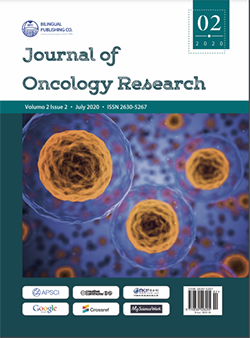Lead to Elevate the Temperature and Speed of Emergency Rescue and Nursing Care of Common Carotid Artery Rupture and Massive Hemorrhage after Operation of Typical Esophageal Cancer
DOI:
https://doi.org/10.30564/jor.v2i2.2480Abstract
Objective: Objective To explore the first aid and nursing of patientswith anastomotic fistula after radical resection of esophagus carcinomacomplicated with major carotid hemorrhage. Methods: The clinical dataof anastomotic fistula complicated with carotid artery rupture and massivehemorrhage after radical resection of typical esophageal carcinoma wereanalyzed and summarized. Results: Through the close cooperation ofmedical care, the rescue was successful. Conclusion: Earlier preventionobservation, raising first aid consciousness and actively cooperating withdoctors can improve the success rate of rescue.Keywords:
Esophageal cancer; Anastomotic fistula; Rupture of the common carotid artery; Hemorrhoea; First-aidReferences
[1] FreddieBray, Jacques Ferlay, IsabelleSoerjomataram, et al. Global Cancer Statistics 2018: GLOBOCAN Estimates of Incidence and Mortality Worldwide for 36 Cancers in 185 Countries[J]. CA CANCER J CLIN, 2018, 68: 394-424.
[2] Wanqing Chen, Changfa Xia, Rongshou Zheng, et al. Disparities by province, age, and sex in site-specific cancer burden attributable to 23 potentially modifiable risk factors in China: a comparative risk assessment[J]. Lancet Glob Health, 2019, 7: e257-69.
[3] Guangling Zhen, Xiaofeng Mu, Jidong Wang, et al. Analysis of prevention and nursing measures of anastomotic fistula after esophageal cancer operation[J]. Anhui Medical And Pharmaceutical Journal, 2014, 18(1): 181-183.
[4] Schniewind B, Schafmayer C, Voehrs G, et al. Endoscopic endoluminal vacuum therapy is superior to other regimens in managing anastomotic leakage after esophagectomy: a comparative retrospective study[J]. Surgical Endoscopy, 2013, 27(10): 3883-3890.
[5] Shaorong Jiang, Jianjun Guo, Jiehua Mao. Operation cooperation and postoperative nursing of 30 cases of bedside tracheotomy after endotracheal intubation[J]. Modern Journal Of Integrated Traditional Chiense And Western Medicine, 2004, 13(5): 669-670.
[6] Long Qiu, Xianglan Li, Song Zhao, et al. Analysis of risk factors of neck esophagogastrostomy fistula after esophagogastrostomy for esophageal cancer[J]. Chinese Journal of Digestive Surgery, 2017, 16(5): 483-489.
[7] Heller KS, Strong EW. Carotid arterial hemorrhage after radical head and neck surgery. Am J Surg, 1979, 138: 607-610.
[8] Lei Zhang, Xiaoying Zhang, Ning Liu, et al. Experience in the treatment of anastomotic fistula after esophagectomy for esophageal and cardiac carcinoma[J]. Jouranl Of Southeast University (Medical Science Edttion), 2012, 21(3): 252-254.
[9] Frawley T, Beqley CM. Cases and prevention of carotid artery rupture. British Journal of Nursing, 2005 Dec 8-2006 Jan 11, 14(22): 1198-202.
[10] Elles S, Jonna K, Richard van H, et al. Nutrition in peri-operativeesophageal cancer management[J]. Expert ReviewOf Gastroenterology& Hepatology, 2017, 11(7): 663-672.
[11] Junhua Yang. Nursing care of patients with anastomotic leakage after esophagectomy[J]. Aerospace Medicine, 2011, 22(5): 817-818.
[12] Guangyi Yang, Wenzhong Su, Xiaoming Li, et al. Cervical open drainage after cervical anastomosis of esophageal carcinoma[J]. China Practical Medical, 2015, 10(20): 66-67.
Downloads
How to Cite
Issue
Article Type
License
Copyright and Licensing
The authors shall retain the copyright of their work but allow the Publisher to publish, copy, distribute, and convey the work.
Journal of Oncology Research publishes accepted manuscripts under Creative Commons Attribution-NonCommercial 4.0 International License (CC BY-NC 4.0). Authors who submit their papers for publication by Journal of Oncology Research agree to have the CC BY-NC 4.0 license applied to their work, and that anyone is allowed to reuse the article or part of it free of charge for non-commercial use. As long as you follow the license terms and original source is properly cited, anyone may copy, redistribute the material in any medium or format, remix, transform, and build upon the material.
License Policy for Reuse of Third-Party Materials
If a manuscript submitted to the journal contains the materials which are held in copyright by a third-party, authors are responsible for obtaining permissions from the copyright holder to reuse or republish any previously published figures, illustrations, charts, tables, photographs, and text excerpts, etc. When submitting a manuscript, official written proof of permission must be provided and clearly stated in the cover letter.
The editorial office of the journal has the right to reject/retract articles that reuse third-party materials without permission.
Journal Policies on Data Sharing
We encourage authors to share articles published in our journal to other data platforms, but only if it is noted that it has been published in this journal.




 Aims and Scope
Aims and Scope Li Fan
Li Fan

